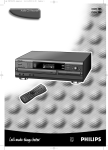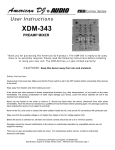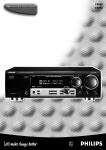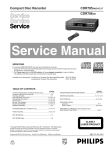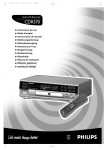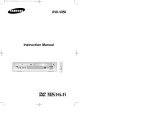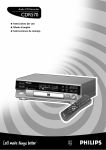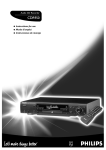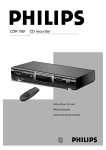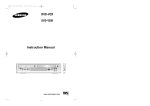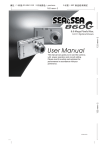Download Philips CDR785 3-Disc CD Recorder
Transcript
CONTROLS AND CONNECTIONS 2 3 4 56 CDR 785 7 8 9 0 ! @ # $ % ^ & English 1 AUDIO CD RECORDER ON/OFF REPEAT CD TEXT SHUFFLE DISPLAY STEP CD 1 STOP TEXT TOTAL TRACK TIME TOTAL REM CD TEXT EDITING REC TRACK TIME RECORD 1 CD-CHANGE 2 3 4 5 6 CD RW CD 3 7 8 CD RW RECORD RECORD IN IN PROGRESS PROGRESS OPEN/CLOSE TEXT PROG TRACK EDIT CDR 9 10 11 12 13 14 15 16 17 18 19 20 + COMPILE COMPILE DISC DISC ALL ALL PROGRAM PROGRAM SHUFFLE SHUFFLE REPEAT REPEAT TRACK TRACK EDIT EDIT JOG CONTROL COMPILE CD DIGITAL 12 OPTICAL12 ANALOG FINALIZE ALC REC TYPE NO AUX YES ERASE AUTO LEVEL CONTRO REC LEVEL BALANCE CD CD CD 2 PLAY/PAUSE FINALIZE L OPEN/CLOSE CD RECORDER MIC PHONES * ( ) ¡ ™ £ ≤ Controls on the front General 1 ON/OFF .......................turns the CD recorder/changer ON and OFF ON/OFF indicator.....lights up when the set is switched on 2 PLAY/PAUSE ; 2 ....starts play/interrupts play 3 SHUFFLE ....................plays discs in changer, program or CD(RW) in recorder in random order 4 REPEAT.......................repeat play (All, program or track) 5 CD TEXT .....................makes CD text scroll over display once 6 DISPLAY.....................selects display information/text 7 IR sensor ...................receives signals from the remote control 8 Display.........................information screen 9 AUX.............................selects external input 0 CDR ............................selects CDR display/keys & YES..............................- selects settings in Text Edit and Track Edit mode .....................................- stores Text settings .....................................- plays selected tracks .....................................- programs track numbers ( STOP 9.......................stops playback or recording ) MIC(rophone)..............microphone jack Level ...........................microphone volume control ™ PHONES.....................jack for headphones Level ...........................headphones volume control £ CD 1, 2, 3 ...................select CD 1, 2 or 3/CD changer display and keys ª NO ..............................- deletes tracks from a program .....................................- deletes complete program .....................................- deletes text in Text Edit mode º Q ............................- searches backward .....................................- reviews the tracks in a program .....................................- controls the cursor in different menus (Text Edit and Track Edit) R ............................- searches forward .....................................- reviews the tracks in a program .....................................- controls the cursor in different menus (Text Edit and Track Edit) ∞ § ≥ • ª º ⁄ ¤ ⁄ ¡ JOG CONTROL ™.- previous/next disc/track (play and program mode) .....................................- recording level control (recording) .....................................- balance control (recording) .....................................- selects settings (menu on) CD changer % PROG(ram)..................opens/closes program (review) memory ^ TRACK EDIT ..............opens Track Edit mode to create your own ‘tracks’ * OPEN/CLOSE /........opens/closes disc tray ¡ CD CHANGE ..............selects disc in CD changer ≤ Disc tray CD recorder ! Recording keys CD ™ CD.....................selects high speed/auto finalise recording mode COMPILE CD .............selects high speed recording mode/opens program memory REC(ord) TYPE ...........selects other recording modes @ REC(ording) LEVEL.....enables the EASY JOG key to set the recording level control # BALANCE...................enables the EASY JOG key to set the balance $ TEXT/store.................opens Text Edit mode and and stores entered text ∞ Disc tray § ERASE.........................erases recordings ≥ Recording Led ..........- Blue in Stop and Play mode .....................................- Red during recording .....................................- Red blinking during erasing • FINALIZE....................finalases/unfinalises disc ¤ OPEN/CLOSE /........opens/closes disc tray Note: Unless stated otherwise, all controls are on the front of the CD recorder/changer. When provided on the remote control, you can also use the corresponding buttons, after selecting the CD recorder or CD Changer by pressing CD-R or CD 1, CD 2,or CD 3. 9 CONTROLS AND CONNECTIONS English L R OPTICAL IN IN OUT ANALOG IN OUT DIGITAL AC MAINS 1 Connections at the back 1 Connection to power 2 ANALOG IN.............connects to the line output of a tape deck, amplifier or other analogue source 3 ANALOG OUT CDR & CD ..................................connects to the line input of an amplifier. (left and right) 4 DIGITAL IN..............connects to the digital coaxial output of an external CD player 5 DIGITAL OUT CDR & CD ..................................connects to the digital coaxial input of e.g. amplifier or recording device 6 OPTICAL IN.............connects to the digital optical output of an external CD player 10 23 4 5 6 INSTALLATION English Connections general Analog connections For playback on the CD recorder from the CD changer deck the following outputs are present: – Digital coaxial output (CD & CD-R) – Analog output (CD & CD-R) We advise you to connect these to the TAPE or CD-R input on your amplifier. This connection must be made for playback on the CD recorder deck as well as the CD changer deck (cord 2). Cord 1 is only required if you want to make recordings from an external analog source. RECEIVER/AMPLIFIER For external recording the following inputs are present: – Digital optical input – Digital coaxial input – Analog input (stereo) IN OUT TAPE/CDR The connections you make will depend upon the possibilities your audio equipment offers. Please refer to the user manuals for your other audio equipment first. Digital recordings (optical or coaxial) give the best performance in audio and usability (e.g. auto-track). (The digital optical connection is less sensitive to external disturbances). If your equipment does not offer digital connections, the high quality Analog-Digital-Convertor of your set will ensure very good audio performance when recordings are made from the analog input. Playback via the digital coaxial output of the CD recorder gives the best audio performance. If your equipment does not offer digital connections, the high quality Digital-Analog-Convertor of the set ensures a very good sound quality via the analog output. We advise you to always establish both digital and analog connections. In this way you can always make analog recordings when digital recording is not possible. We have described the most common ways of connecting the CD recorder. If you still have difficulties with the connections you can always contact the Philips Consumer Service desk in your country. 2 1 L L L R R IN R OUT IN OUT ANALOG DIGITAL OPTICAL IN CD RECORDER Use the audio cords supplied. Connect the red plugs to the R jacks, and the white plugs to the L jacks. 1 For external recording, connect cord 1 between the ANALOG IN-jacks on the set and the CDR LINE- or TAPE OUT-jacks of an amplifier. Note: For recording directly from a CD player or tape deck, the analog input of the set should be connected to the analog output of the CD player or tape deck. 2 For playback, connect cord 2 between the ANALOG OUTjacks on the set and the input jacks of an amplifier e.g. TAPE IN, CD-R or AUX. Note: Never use the PHONO input. 14 Digital coaxial connections Digital optical connections This connection is required if you want to make recordings from an external CD player with a digital coaxial output. This connection is required if you want to make recordings from an external CD player with a digital optical output. English INSTALLATION RECEIVER/AMPLIFIER RECEIVER/AMPLIFIER 1 IN 1 OUT IN TAPE/CDR OUT TAPE/CDR 2 2 L L R IN OUT IN OUT ANALOG DIGITAL R IN OUT IN OUT ANALOG DIGITAL OPTICAL IN 3 CD RECORDER IN OPTICAL IN 4 CD RECORDER OUT OPTICAL OUT IN DIGITAL CD PLAYER 1 For external recording, connect the cord 3 between the DIGITAL IN-jack on the set and the DIGITAL OUT-jack of an external CD player. Note: Your set is equipped with a digital coaxial output (common output for CD recorder & CD changer deck). This output can be used for digital playback. (e.g. Philips receiver FR960 or FR970.) OUT OPTICAL OUT DIGITAL CD PLAYER When connecting the Digital Optical cord, make sure it is fully inserted until there is a click. 1 Remove the dust caps from the digital optical connection. (We recommend you save the cap.) 2 For external recording, connect a fibre-optic cord 4 between the digital optical input of the set and the digitaloptical output of an external CD player. Note: For playback, the digital coaxial outputs or analog outputs of the CD Changer and CD recorder should be connected to an amplifier. 15 INSTALLATION English Power supply/Mains Inserting batteries in the remote control AC MAINS The type plate is located on the rear of the set. 1 Check whether the power voltage as shown on the type plate corresponds to your local power voltage. If it does not, consult your dealer or service organisation. 2 Make sure all connections have been made before switching on the AC power supply. 2x AA, LR6, UM-3 / 1,5 V 3 Connect the power cord supplied to AC POWER ~ and to the wall outlet. This switches on the AC power supply. 4 Press ON/OFF to switch on the set. ➜ PHILIPS CD RECORDER will be displayed. • Press ON/OFF again to switch off the set. • Press y on the remote control to switch the set to Standby mode. When the set is switched to standby, it is still consuming some power. To disconnect the set from the power completely, remove the power plug from the wall outlet. For users in the U.K.: please follow the instructions on page 3. 1 Open the battery compartment cover. 2 Insert 2 batteries (AA, LR6 or UM-3; as supplied) as shown. 3 Replace the cover. Note: We recommend you use 2 batteries of the same type and condition. Setup recommendations – Place the set on a solid, vibration free surface. – Make sure there is sufficient space around the set to prevent overheating. – Do not place the set near a source of heat or in direct sunlight. – Do not use the set under extremely damp conditions. – If the set is placed in a cabinet, make sure that a 2.5 cm space remains free on all sides of the CD recorder for proper ventilation. – Active mobile phones near to the set may cause malfunctions. 16 Batteries contain chemical substances, so they should be disposed of properly.






